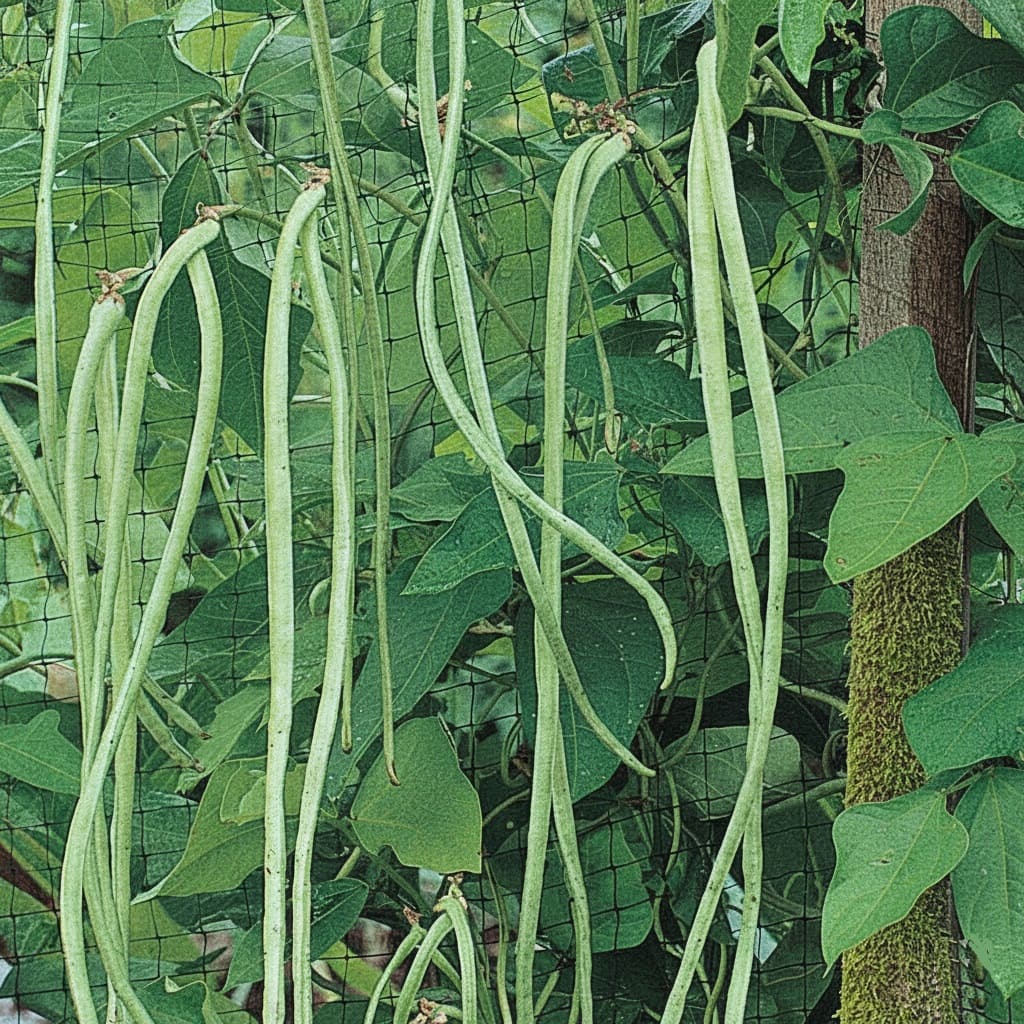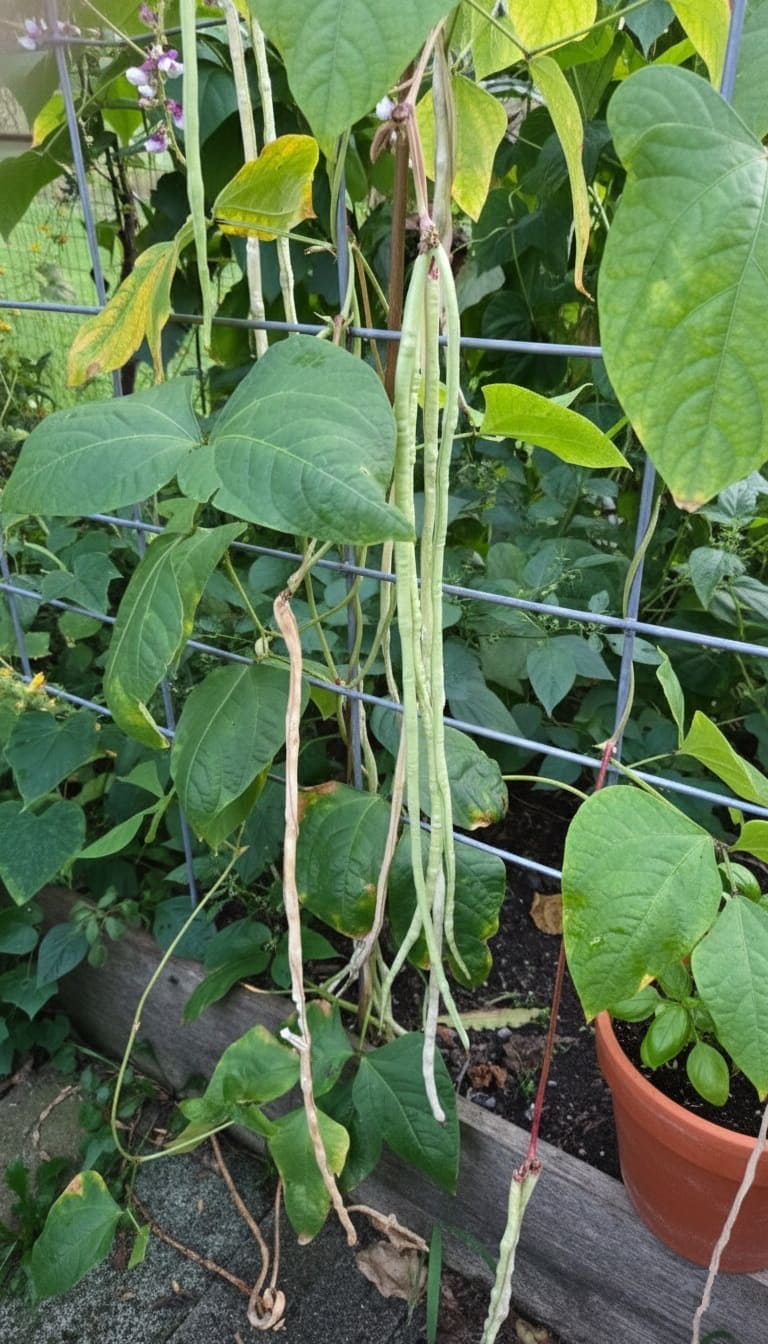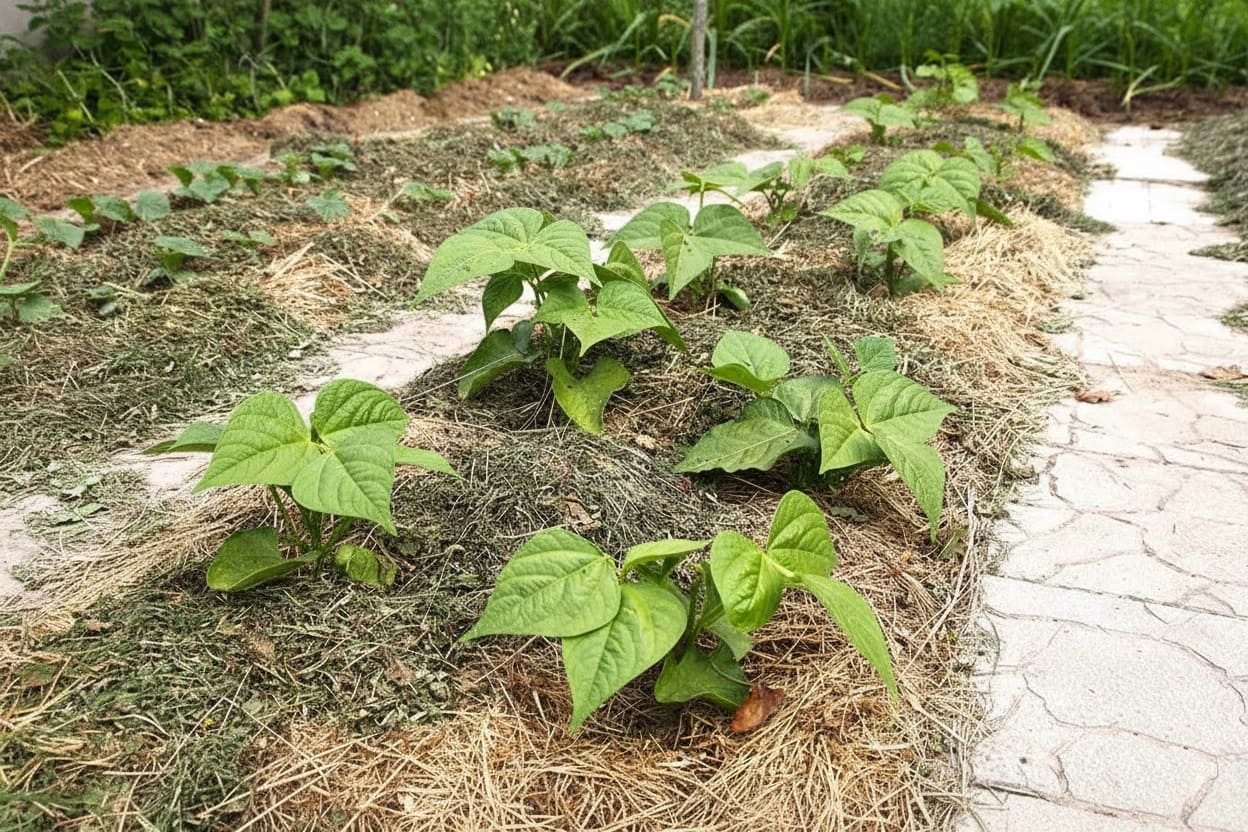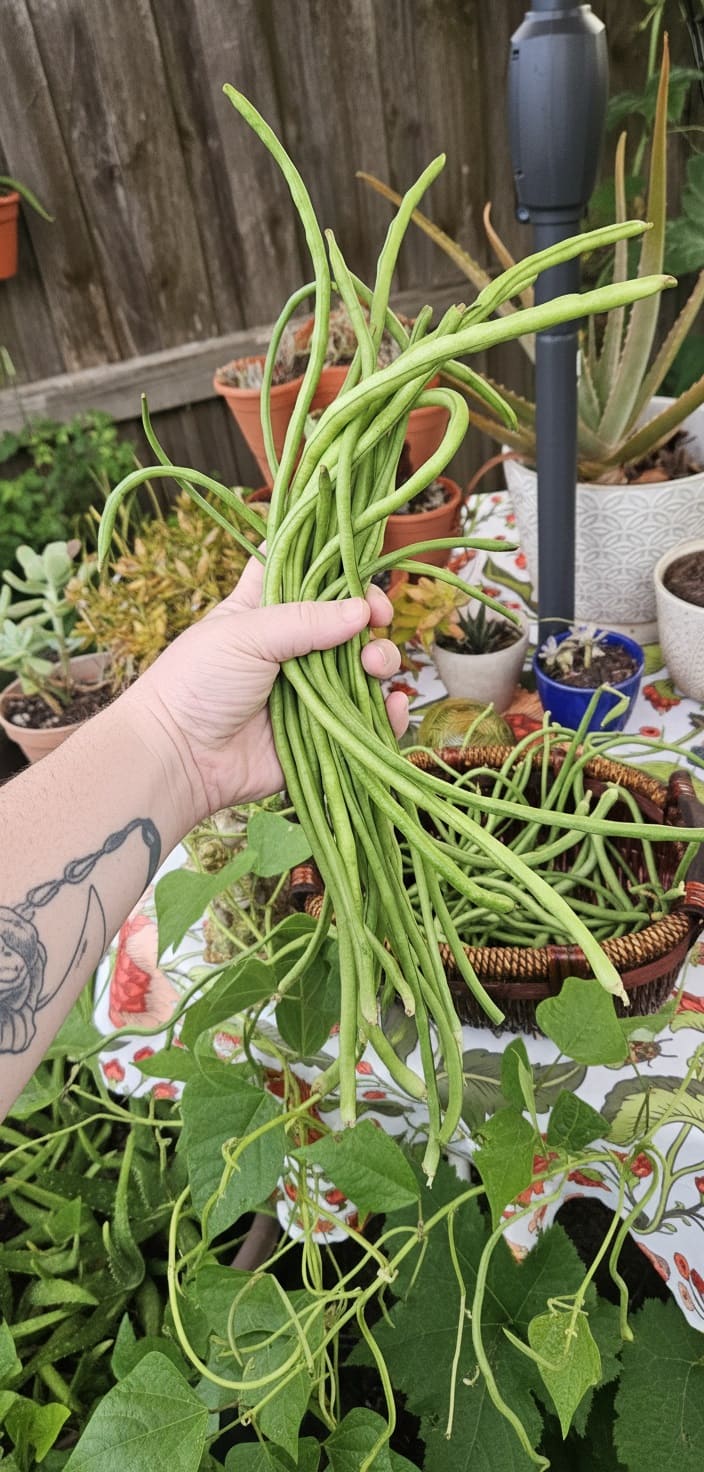Picture this: It’s mid-July, your snap beans have given up in the heat, your tomatoes look miserable, but there—climbing vigorously up your trellis—is a plant loaded with glossy, slender pods stretching 18 inches long, still tender and begging to be picked.
Welcome to yard long beans, the heat-loving legume that thrives when other vegetables struggle.
If you’ve never grown yard long beans (also called Chinese long beans, asparagus beans, or snake beans), you’re missing out on one of the most productive crops for warm-season gardens.
By the end of this guide, you’ll understand exactly how to plant, grow, and harvest these remarkable vegetables—and why experienced gardeners swear by them.
What Exactly Are Yard Long Beans?
Here’s something that surprises most gardeners: despite looking like stretched-out pole beans, yard long beans (Vigna unguiculata subsp. sesquipedalis) are actually more closely related to black-eyed peas and cowpeas.
This family connection explains their exceptional heat tolerance and why they flourish when temperatures soar into the 90s and beyond.
The plants produce vigorous vines reaching 8-12 feet tall with attractive trifoliate leaves. In midsummer, they burst into distinctive paired purple, white, or yellow flowers.
Once pollinated—primarily by bees—these flowers transform into incredibly long, slender pods ranging from dark green to purple, red, or mottled combinations.
The name “yard long bean” is both accurate and misleading. While pods can reach three feet under ideal conditions, they’re actually best harvested at 12-18 inches long and pencil-thin. At this stage, they’re tender, sweet, and snap crisply—perfect for fresh eating.
Why Yard Long Beans Deserve a Spot in Your Garden
Exceptional Heat Tolerance
While regular green beans sulk and drop flowers at 95°F, yard long beans are just getting started. They thrive in hot, humid conditions that stress most vegetables, making them ideal for southern gardens, tropical climates, and brutal summer weeks.
Gardeners in USDA zones 5 and up can successfully grow them, though zones 7-11 will find them especially rewarding.
Remarkable Productivity
A small planting of 6-8 plants can easily provide enough beans for a family of four, with plenty to preserve or share.
These legumes are prolific producers, generating new flowers as long as you keep harvesting—giving you a continuous supply rather than the one-time flush typical of bush beans.
Space-Efficient Vertical Growing
Despite needing a sturdy trellis, their vertical growth habit means a 2-foot wide bed can produce an astonishing harvest. This makes them perfect for small gardens or alongside other crops that appreciate afternoon shade.
Unique Flavor Profile
The flavor is distinctly different from green beans—nutty, slightly asparagus-like, with a firmer, meatier texture that holds up beautifully to stir-frying, steaming, and even pickling. Some varieties have a subtle sweetness that shines with just butter and salt.
Low-Maintenance Legumes
As nitrogen-fixing legumes, they require less fertilizing than most vegetables while actually improving your soil. They tolerate some drought once established and have relatively few pest problems compared to other summer crops.
Choosing the Right Variety: A Critical Decision
Not all yard long beans perform equally across climates. Understanding variety characteristics prevents disappointment.
Black-Seeded Varieties (Early, Productive)
Asparagus Bean matures in 65-75 days with dark green pods and purple tips. The asparagus-like flavor makes it distinctive, though pods are delicate and need light cooking. This is the earliest and most reliable variety for short-season areas.
Taiwan Yard Long Bean produces extraordinarily long pods (up to 30 inches) but can become hollow in extreme heat. The harvest window is narrow, requiring daily checking. Better suited for experienced gardeners.
Red-Seeded Varieties (Firm, Flavorful, Heat-Loving)
Chinese Red Noodle Bean (75-85 days) produces deep burgundy pods that turn purplish-gray when cooked—though vinegar restores the red!
These beans are exceptionally firm and crunchy with a nutty flavor. They make outstanding pickled dilly beans and handle heat beautifully.
Purple varieties retain their stunning color through cooking, turning nearly black. They’re typically sweeter and firmer than green varieties, excellent for both raw and cooked applications.
Bush Varieties (Container-Friendly, Fast)
Yancheng Bush and Stickless Wonder grow only 18 inches tall, producing 11-12 inch pods in just 50 days—the fastest yard long beans available. Perfect for containers, small spaces, or short growing seasons, though yields are lower than pole varieties.
👉 Discover 29 Types of Beans Every Home Cook Should Know: Nutrition, Cooking Tips & More
A Critical Warning About Day-Length Sensitivity
This is crucial:
Some tropical yard long bean varieties are day-length sensitive, meaning they won’t flower until days shorten to approximately 12 hours—which in most of North America means late August or September.
These varieties will grow beautiful vines all summer but produce beans too late for proper harvest before frost.
When ordering from importers or unfamiliar sources, specifically ask whether varieties are suitable for your latitude and growing season. Stick with varieties bred for temperate climates or purchased from reputable U.S. seed companies if you’re uncertain.
Timing Your Planting: Patience Prevents Problems
Yard long beans absolutely hate cold soil. While you might plant snap beans at the first hint of spring, resist that urge here. These heat-lovers need soil temperatures of at least 60°F, with germination and growth dramatically faster at 70-80°F.
Regional guidelines
- Zones 7-9: Plant 1-2 weeks after last spring frost (mid to late May)
- Zones 10-11: Plant March through July
- Zones 5-6: Wait until late May or early June; consider black plastic mulch to warm soil faster
A simple soil thermometer test can save frustration. Push it 2-3 inches into the ground in the morning—if it reads below 60°F, wait another week. Seeds planted in cold, wet soil simply rot.
Succession Planting for Continuous Harvest
For non-stop production, make additional sowings every 2-3 weeks through midsummer. Your last planting should be roughly 75-90 days before your first expected fall frost (depending on variety).
This strategy ensures you have fresh beans from July straight through to frost.
Preparing Your Planting Site
Sun Requirements
Full sun (6-8 hours direct sunlight) is non-negotiable. In extremely hot zones (9-11), afternoon partial shade can prevent stress, though full sun typically produces better yields.
Soil Preparation
These beans tolerate everything from sandy loam to clay as long as drainage is adequate. They prefer pH 5.5-7.5 (slightly acidic to neutral).
Preparation steps:
- Loosen soil 8-10 inches deep
- Mix in 2-4 inches of compost or well-rotted manure
- Avoid high-nitrogen fertilizers—excess nitrogen creates foliage at the expense of pods
- If soil is heavy clay, add coarse sand to improve drainage
Because yard long beans fix their own nitrogen through beneficial root bacteria, they actually enrich your soil for following crops, making them excellent for crop rotation.
Building Support Structures First
Install your trellis before planting—adding support later risks damaging the shallow root system. Your structure needs to support vigorous vines reaching 10-12 feet tall that can become heavy when loaded with beans.
Effective options:
- Bamboo tripods (lash 3-4 poles together at the top, spread bases 3-4 feet apart) work beautifully in limited spaces and create fun hideaways underneath.
- Row trellising uses 7-8 foot posts every 6-8 feet with cotton or jute twine strung horizontally at 12-inch intervals. At season’s end, pull down vines and twine together for easy composting.
- Cattle panel arches create beautiful tunnels with beans hanging down from the top for easy harvesting.
- Fence growing requires adding vertical strings or wires—bean vines need something to actively twine around, not just lean against.
Aim for 6-7 feet of climbing height. Going taller makes harvesting difficult and beans hard to spot.
👉 Discover more Creative Pole Bean Support Ideas That Actually Work for Your Garden
Planting Your Beans: Direct Sowing vs. Starting Indoors
Direct Sowing (Strongly Recommended)
Direct sowing is ideal—these plants have sensitive root systems and generally resent transplanting.
Optional but beneficial: Treat seeds with legume inoculant containing Bradyrhizobium bacteria before planting. This establishes nitrogen-fixing root nodules. Simply moisten seeds, sprinkle with inoculant powder, shake to coat, and plant immediately.
Planting steps:
- Make holes 1-2 inches deep
- Space seeds based on your setup: 3-4 seeds per tripod pole; 6-12 inches apart for row trellises; as close as 4-6 inches for intensive management
- Drop one seed per hole, cover with soil, pat down gently
- Water thoroughly but gently—keep soil moist (not waterlogged) until germination
Germination takes 6-12 days when soil temperatures are right. Warmer soil means faster germination. Once seedlings emerge with first true leaves, thin to final spacing if needed.
Starting Seeds Indoors (Short Season Climates Only)
For zones 5-6, start seeds indoors 3-4 weeks before transplant date (1-2 weeks after last frost). Use 4-inch biodegradable pots to minimize root disturbance. Fill with seed-starting mix, plant 1-2 inches deep, and maintain 70-75°F (a heat mat helps significantly).
When seedlings develop 2-3 true leaves, harden off for one week. Transplant by cutting through pot sides and setting the entire thing in the ground at soil level.
Be realistic: even with perfect technique, you may lose some transplants. Many gardeners prefer direct sowing slightly later and accepting a shorter harvest window.
Caring for Your Growing Beans
Watering Wisdom
Yard long beans are more drought-tolerant than snap beans, but “tolerant” doesn’t mean “thriving.” For the best production, aim to provide about 1 inch of water per week through a combination of rainfall and irrigation.
The critical watering times are:
- During germination (keep soil consistently moist)
- When flowers appear (drought stress causes blossom drop)
- During pod development (inadequate water leads to small, fibrous beans)
Water at the base of plants rather than overhead to reduce the risk of fungal diseases. Morning watering is ideal—it allows foliage to dry before nightfall.
To Fertilize or Not to Fertilize?
Thanks to their nitrogen-fixing abilities, yard long beans need less fertilizer than most vegetables.
If you’ve amended your soil with compost before planting, additional fertilizing usually isn’t necessary. In fact, over-fertilizing—especially with high-nitrogen fertilizers—creates problems: massive vines with few flowers and even fewer beans.
Signs you might need to fertilize:
- Very pale green or yellowing foliage (not from pests or disease)
- Slow growth despite adequate water and sun
- Poor flowering
If fertilizing becomes necessary, use a balanced organic fertilizer or one higher in phosphorus and potassium (like tomato fertilizer) rather than nitrogen. Apply once when flowers first appear, following package directions.
Mulching Matters
Once seedlings are 3-4 inches tall, apply a 2-3 inch layer of organic mulch around plants. Straw, shredded leaves, or grass clippings all work well. Mulch serves multiple purposes:
- Suppresses weeds
- Retains soil moisture
- Keeps soil temperatures more consistent
- Breaks down to add organic matter
Training and Pruning
Bean vines climb by twining counterclockwise around supports but sometimes need gentle guidance when young. Check every few days and loosely direct wayward vines toward supports.
- Growth expectations:
Don’t panic if newly germinated seedlings stall for a couple weeks—they’re establishing roots. Once that foundation is in place and temperatures climb, they’ll grow several inches per day, reaching the top of a 7-foot trellis in 4-6 weeks.
- If vines top your trellis:
Allow them to cascade over and grow downward, or train them horizontally along the top.
Some gardeners in long-season areas selectively prune older lower leaves later in the season to improve air circulation and trigger new flowering, though this isn’t necessary in most temperate climates.
Companion Planting for Healthier Beans
Strategic companion planting improves pollination and reduces pest pressure.
Beneficial companions:
- Marigolds repel aphids and Mexican bean beetles
- Nasturtiums act as trap crops for aphids while repelling beetles
- Garlic and rosemary deter various pests with their strong scents
- Flowering herbs (basil, dill, cilantro) attract beneficial insects that prey on pests
Avoid planting near: Alliums (onions, garlic) can inhibit growth in some legumes, and fennel inhibits most vegetables.
Managing Pests Effectively
Yard long beans have fewer pest problems than many vegetables, but vigilance prevents issues from escalating.
Aphids (Most Common)
Small soft-bodied insects cluster on new growth, flower buds, and leaf undersides, often accompanied by ants (which “farm” them for honeydew) and sticky residue.
Management: Blast off with strong water spray daily for a week. If persistent, apply insecticidal soap to leaf undersides, introduce ladybugs or lacewings, or use neem oil for severe infestations.
Avoid over-fertilizing with nitrogen, which creates the tender growth aphids love.
Mexican Bean Beetles
Orange, spotted beetles that skeletonize leaves. Their orange larvae are spiny and equally destructive.
Management: Handpick adults and larvae, crushing egg clusters on leaf undersides. Apply spinosad for severe infestations. Companion planting with marigolds, nasturtiums, and rosemary provides excellent deterrence.
Thrips
Cause silver or bronze speckling on leaves, with tiny black specks visible. Generally don’t cause serious harm but monitor populations.
Management: Strong water spray, insecticidal soap, or neem oil for heavy infestations. Encourage predatory insects through companion planting.
Slugs and Snails
Primarily attack young seedlings and beans near ground level.
Management: Hand-pick in evening, use copper barriers around beds, apply diatomaceous earth around plants (reapply after rain), or use beer traps.
Spider Mites
Cause stippling or bronzing on leaves with fine webbing on undersides. Leaves may eventually drop.
- Management: Spray leaf undersides thoroughly with water (mites hate moisture), apply insecticidal soap or neem oil. Interestingly, many gardeners report yard long beans are less susceptible than regular snap beans.
- General pest prevention: Healthy plants resist pests better. Ensure adequate water, avoid over-fertilizing, encourage beneficial insects through companion planting, and inspect plants regularly to catch problems early.
Disease Management
Yard long beans are generally disease-resistant, but prevention is easier than cure.
Damping Off
Fungal disease causing seedlings to collapse at soil line. Occurs in cool, damp conditions.
Prevention: Wait for soil to warm before planting, ensure good drainage, avoid overwatering, and use quality seed from reputable sources.
Mosaic Viruses (Bean Common Mosaic, Cucumber Mosaic)
Yellow, mosaic-like patterns on leaves with stunted growth. Spread by infected seed and aphids.
Prevention/Management: Buy certified disease-free seed from trusted sources, control aphids promptly, remove and destroy infected plants immediately, clean tools after handling diseased foliage, and avoid touching plants when wet.
Powdery Mildew
White, flour-like coating on leaves, occurring in humid but mild conditions.
Prevention: Follow spacing recommendations for good air flow, water at soil level (not overhead), avoid working among wet plants, and remove affected leaves promptly. Apply sulfur-based fungicide for severe cases.
Root Rot
Caused by waterlogged soil and poor drainage, leading to brown, mushy roots and wilting despite adequate water.
- Prevention: Ensure excellent drainage, avoid overwatering, and rotate crops—never plant beans in the same location two years running.
- General disease prevention: Water in morning so foliage dries quickly, maintain good air circulation through proper spacing, practice crop rotation, and never work among wet plants (this spreads disease rapidly).
Harvesting: The Art of Perfect Timing
Getting harvest timing right makes the difference between tender, sweet beans and tough disappointments.
When to Pick
The sweet spot: Harvest when pods are approximately pencil-diameter (¼ inch thick) and 12-18 inches long. At this stage, seeds inside should be barely visible, pods should feel firm but flexible, color should be vibrant, and the bean should snap cleanly when bent.
Pods can reach 24-36 inches under perfect conditions, but they’re past their prime—becoming hollow with prominent seeds, turning pale, and developing tough fibers.
👉 Learn When and How to Harvest Vegetables for Peak Flavor: Timing & Tips for Every Crop
How to Harvest
Hold the stem with one hand and twist or snap the pod off with the other, preventing vine damage or accidental pulling. Better yet, use scissors or pruning snips, being careful not to damage flower stems that continue producing multiple flowers from the same point.
Harvest Frequency
Pick every 1-3 days during peak production. When you allow beans to fully mature on the vine, the plant receives hormonal signals to stop flowering and focus on seed development. Consistent harvesting keeps production going strong.
Harvest in early morning after dew dries but before the day heats up. Beans picked in afternoon heat tend to be flaccid and store poorly.
When Production Overwhelms You
Too many beans is a good problem to have, with several solutions:
- Temporarily slow production by picking less frequently—mature pods signal the plant to stop flowering. Resume frequent picking when you’re ready for more.
- Preserve the harvest through freezing, pickling, or canning (see preservation section).
- Share generously with neighbors, coworkers, or food banks—fresh yard long beans make memorable gifts.
- Let some mature for dry beans—the mature seeds can be dried like cowpeas and stored for winter soups and stews.
Storing and Preserving Your Harvest
- Fresh Storage
Freshly harvested beans keep 3-5 days refrigerated. Rinse under cool water, dry thoroughly, wrap loosely in paper towel, place in unsealed plastic bag or container, and store in crisper drawer.
- Freezing
Cut beans into 1-2 inch lengths, blanch in boiling water for 3 minutes, plunge into ice water, drain thoroughly, spread on baking sheet and freeze until solid, then transfer to freezer bags. Use within 6-12 months.
- Pressure Canning
Because beans are low-acid vegetables, pressure canning is required. Always follow USDA-approved canning guidelines. Process yard long beans the same way as snap beans.
- Pickling
Red Noodle beans make spectacular pickled dilly beans, maintaining exceptional crunch and developing gorgeous deep red color in vinegar brine.
- Dehydrating
Cut into small pieces, blanch briefly, and dehydrate at 125-135°F until completely dry and brittle. Perfect for soups and camping meals.
👉 Here’s How to Dehydrate Apples at Home: Easy Steps for Perfect Results
From Garden to Kitchen: Culinary Adventures
One of the joys of yard long beans is their culinary versatility. Unlike regular green beans that turn mushy when overcooked, these beans maintain their texture and signature crunch even after extended cooking.
Stir-Frying (The Classic Preparation)
Cut beans into 2-inch lengths and stir-fry quickly over high heat with:
- Minced garlic and fresh ginger
- A splash of soy sauce or fish sauce
- A pinch of sugar
- Optional: ground pork, shrimp, or tofu
The beans cook in just 3-5 minutes while retaining their beautiful crunch.
Dry-Fried Long Beans (Sichuan Style)
This restaurant favorite is surprisingly easy at home:
- Remove stems and cut beans into 3-inch segments
- Heat oil in a wok or large skillet until shimmering
- Add beans and cook, stirring occasionally, until they develop blistered spots
- Push beans aside, add minced garlic, ginger, and ground pork
- When pork is cooked, combine everything
- Season with soy sauce, a touch of vinegar, and Sichuan peppercorns if available
Raw in Salads
Young, tender yard long beans can be eaten raw—they’re crunchy and slightly sweet. Try them in Thai-style salads like green papaya salad, where they add texture and substance.
Pickling
Red Noodle beans make spectacular pickled dilly beans. Their firm texture stands up beautifully to the pickling process, and the burgundy color transforms to a gorgeous deep red in vinegar brine.
Braising and Simmering
Unlike snap beans, yard long beans excel in slow-cooked dishes. Add them to:
- Curries (they won’t disintegrate)
- Soups and stews (add them in the last 15-20 minutes)
- Braised dishes with coconut milk
- Minestrone (they hold up through reheating)
Simple Butter and Garlic
Sometimes simple is best: Steam beans until just tender (about 5 minutes), then toss with butter, minced garlic, salt, and pepper. The nutty flavor of the beans shines through.
Saving Seeds for Next Year
Most yard long bean varieties are open-pollinated, making seed saving straightforward.
The process:
- Select seed pods early in the season from the healthiest, most productive plants and mark them
- Leave these pods on the vine to fully mature—they’ll change to pale yellow or tan and feel papery
- If frost threatens, pick mature pods and finish drying indoors in a well-ventilated area
- Shell beans once pods are crispy-dry—each pod typically contains 10-15 seeds
- Dry seeds an additional week spread on paper towel
- Store in airtight containers in a cool, dark place (viable for 2-3 years)
Bonus: Accidentally over-mature beans on your plants? You’ve just started next year’s seed collection!
Troubleshooting Common Problems
Seeds Aren’t Germinating
- Causes: Soil too cold (most common), seeds rotted in cold wet soil, planted too deep, old non-viable seeds.
- Solutions: Wait until soil reaches 65-70°F. Seeds rot within days in cold, wet conditions. Start over with fresh seeds once conditions improve, or start indoors in warmer conditions.
Seedlings Aren’t Growing
- Causes: Night temperatures still too cool, insufficient sunlight, nutrient-poor soil, root disturbance from transplanting.
- Solutions: Be patient—beans often pause 1-2 weeks after germination while establishing roots. If nights are below 60°F, growth will be slow. Once heat arrives, they’ll surge. Ensure 6+ hours direct sun.
Lots of Vines, No Flowers
- Causes: Too much nitrogen, not hot enough yet (day-length sensitivity), plants still young.
- Solutions: If you over-fertilized with nitrogen, wait it out and avoid further fertilizing. Most commonly, plants need another 2-3 weeks and warmer weather. Flowering typically begins 6-8 weeks after planting once temperatures are consistently warm.
Flowers But No Beans
- Causes: Poor pollination, temperature stress during flowering, inconsistent watering.
- Solutions: Encourage pollinators by planting flowers nearby. During heat waves, provide afternoon shade if possible. Ensure consistent soil moisture during flowering—neither drought-stressed nor waterlogged. In greenhouses, manually shake plants or open doors at night to allow insect pollinators access.
Beans Are Tough and Stringy
- Cause: Harvested too late.
- Solution: Harvest earlier when beans are thinner. Check plants more frequently—beans can go from perfect to past-prime in just a day or two during peak production. Once beans show visible seed swelling, they’ve passed ideal eating stage.
Frequently Asked Questions
- Can I grow yard long beans in containers?
Yes! Use containers at least 12 inches wide and 10 inches deep for two plants. Provide sturdy support, use quality potting mix, and water diligently. Bush varieties are especially well-suited for containers.
- How many plants do I need for a family of four?
Six to eight plants provide plenty for fresh eating plus preservation. These beans are extraordinarily productive.
- What’s the difference between green and red varieties?
Green varieties (black-seeded) mature earlier (65-75 days), are slightly more productive, and have delicate, asparagus-like flavor. Red varieties (red-seeded) mature later (75-85 days), are firmer and crunchier, and have sweeter, nuttier flavor.
- Will they cross-pollinate with regular green beans?
No—they’re different species (different genus) so you can save seeds from both without worry.
- My beans taste different from green beans—is something wrong?
Nope! Yard long beans have a distinctly different flavor—nuttier, sometimes mushroom-like with asparagus notes, more savory than sweet. Their texture is denser. This uniqueness is what makes them special.
Final Thoughts
Growing yard long beans combines easy cultivation with impressive results—the kind of crop that makes you look like a gardening genius.
Remember the essentials:
- Wait for warm soil (60°F minimum, 70°F ideal)
- Provide sturdy 6-7 foot trellis before planting
- Direct sow seeds 6-12 inches apart, 1-2 inches deep
- Water consistently but avoid over-fertilizing with nitrogen
- Harvest religiously when beans are pencil-thin
- Embrace their unique flavor
Whether you’re a heat-stressed gardener watching snap beans struggle, an adventurous cook seeking authentic Asian ingredients, or someone who loves growing unusual, productive crops, yard long beans deserve a place in your garden.
Ready to start? Order seeds now—popular varieties sell out as gardening season approaches. Mark your calendar for planting day. Design that trellis. And prepare for neighbors asking: “What are those incredibly long things in your garden?”
What’s your experience with yard long beans? Share your favorite variety or cooking method in the comments below!











